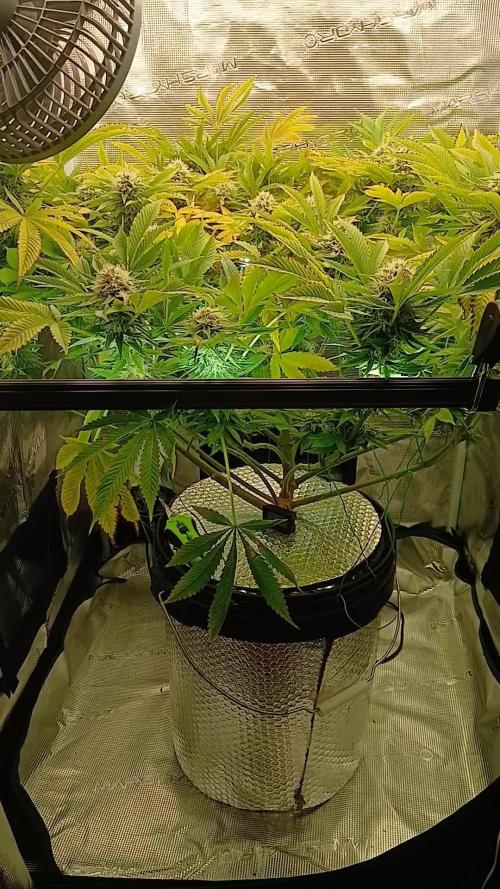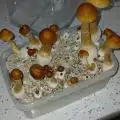The Grow Awards 2026 🏆 































Processing
Likes
8
Share


@eldruida_lamota
Follow
Última semana de floración de estas candy caramelo y es que vaya flores son como rocas muy compactas kio, de lo mejor que e visto también en mucho tiempo fumetillas.
Plantas pequeñas con un buen porte y un buen grosor de tallo, son bastante rápidas a la hora de florecer, os aseguro que las aguantaba una semana más pero por temas de virus y tal decido cortarlas ya que también están bien bastante contento en verdad con esta varieddd.
Mantuve ph hasta el final controlando humedad y temperatura pocas veces desvarío el asunto.
Muy muy contento zambeza hizo un fast bastante curiosa con olores dulces .
Processing
Likes
22
Share


@Silverback_Guerilla
Follow
2/10:
I watered today with about 3/4 gallon each, plus cal-mag, signal, bembe, armor si, a little open sesame, and their final dose of endoboost.
I took photos today, but forgot to snap a shot of the Soooperrunt. She's as tall as the short one now, just not as bushy. I think she'll make a fair amount of bud despite her sloooow start, smaller stature, and smaller pot. The tall one is keeping pace with the biggest plants in the garden.
2/11:
Wife home sick today....postponing construction project to raise the lights....kinda scary....about 10"-12" from the tops now..
2/12:
I woke up to find the tallest of these bitches stretched another few inches and within 9 inches of the lights!!!
I quickly drug everybody out of the closet and undertook the project. In addition to that project, I installed and hooked up my new AC Infinity 6" intake fan. It's pulling in fresh air from the soffit vent on the eave of the attic, and currently feeding the garden with 46f fresh air. I'm able to easily maintain daytime temps in the lower 70f's now. I am able to drive the nighttime temps as low as I want. The only issue is that the outdoor RH varies quite a bit, so I ordered a 30-pint dehumidifier to put in the top of the closet. It will battle with the evaporative cooler while the lights are on to keep it at 45% RH, but after the lights go off, it will lower the RH to 35% unti morning. After another couple of weeks, I'll kill the evap cooler altogether and try to maintain 35% RH 24/7. I'm optimistic that it will be the difference-maker in maintaining lower RH while I'm flushing all the plants during the last couple of weeks. That's usually such a challenge...especially with a bunch of 5 gallon pots.
I also sprayed everybody with boomboom spray to try and mitigate the light burn damage that is likely to ensue.
2/13:
Still stretching... about 12" from the lights again. I will wait to raise the lights until tomorrow when I feed them. I'm seeing calcium deficiency on a few plants, including a #9. Will up the dose tomorrow when I feed.
2/14:
I fed them today with about 3/4 gallon each including grow big, big bloom, tiger bloom, cal-mag, signal, bembe, humic acid, and I switched over from Open Sesame to Beastie Bloomz. Raised the lights another couple of inches. I did some training on them and defo'd a little bit.
2/15:
Installed the new dehumidifier and rigged the continuous drain on it...works great.
2/16:
I rotated the edge plants and removed some old leaves. I added another 22w 3000k 4' bar light under the canopy.
2/17:
I rearranged the garden and defoliated a little bit. That's it for week 8-
Likes
19
Share


@cam0538154
Follow
Fat banana for the win. Super sticky and smells amazing. Going to be a pretty good yield on the 3 I have. The gorilla zkittlez auto seems like it was overly stressed or is experiencing bud rot of some sort. So many bud sites but no actual growth to the twigs. May scrap that and process for edibles.
Processing
Likes
13
Share


@kevgrow
Follow
First time grower - Day 3 - Seedling Stage
Unknown strain, hopefully its a female
Light meter currently reads 101 lux x100
Should I give it more lighting or put it closer to the plant?
Using roots organic soil, should I prepare for nutrient feeding after week 1? And if yes, what nutrients should I feed them?
Likes
55
Share


@Organic_LarF
Follow
High GD community
Week 16,
Zuchinis all around, tomatoes getting ready on a daily. Cucumbers are getting almost mature proportions. Everything going well.
Terra preta
Location: center perma garden
Surface: 125cm x 105cm
Depth: 115cm
The hole was dug out over 3 days, it were very sunny days. 😅
Theres mostly loamsand with a small sandloam bottom that was very hard. The sand was also very compressed and hard. The top layer is this grey dusty soil of about 40cm deep.
At the bottom theres pure sand thats soft, easy drainable.
First step is to fill up the entire bottom with fine chopped wood, progressively using bigger pieces of wood. I try to use some hardwood like oak to for its extra K (potassium = pot ash). A bit of charcoal to.
This will take the entire first day, bcs it needs to have a minimal ticknes of pure ashes of around 5cm. Otherwise, after compressing it with the upcoming layers, the ash-line would almost disappear. Not all the wood needs to be burned entirely. Its a first layer with lots of N and K. Bones can be used to in the fire making the NPK complete. But it can be added also as a separated layer. I dont have that much bone material because my 2 dogs, or eating, or burry them somewere.
Little warning at the end, be aware of your local laws applied to open fires. 😅😉
After a good burn ive got between 8 and 12cm of ashes in total over the entire surface.
A small layer of soil (5cm) is put on top of that. Theres no need to harden out that layer, pressure will to the work and the layers will compress over time into ideal circumstances.
On to the next layer!!
Next is a layer of the compost, but the part that isnt allready decomposed. Its green/brown/yellow of color. And a bit of everything, grass, weeds, leafs and some thin branches.
Another layer soil to cover that up.
Now i formed a thin layer of chopped(10mm) wood(beech), just enough to make a thin,almost 1 piece high, layer. On to this i added a complete wheelbarrel of compost(black) with small pieces of still not completly decomposed materials. Lots of worms here.
On that, you guessed it, an other layer of soil. I try to have both types of soil in that mix, the almost pure sand and the more grey type.
Next, back to the beech. This time the rest of the bag follows. Theres a good layer of around 3cm deep. On this ive layed down some new small woodsticks to make a small fire again. Starting at the center and adding some last branches i found. It turned out really smoky!!
Half way the burn ive opend the core of the fire, trying to spread the small pieces of char over the complete surface. After that, i added for the first time some water here.
And an other layer of soil again, this is just covering up each time. Max 5cm!!
Now we are at the upper half of the pit. Still 50cm to go.
Now ive added some compost again, the green/brown/yellow one, with on top of that, a 15 liter bucket with compressed bokashi fermentated kitchen leftovers. Making a layer out of that and some fresh bokashi juice with 10 liters of water to drain those benificial bacteria into to compost layer just underneath it. This layer is almost 20cm tick.
Again, yeah, soil, 5cm.
Ive bought some blond peat to at to to toplayers. Last 25 to 30cm of soil, is a mix of the peat(20%) and the two other types of soil. First ill do tiny layers of each, last 10cm i try to mix it.
And to finish the job, ive took some 100% reused and composed soil with some perlite in it from past use.
I havent watered a lot, but the meteo predicts a good amount of water in the upcoming days.
The soil that stayed and didnt get back to its original place, ive used to make a new top layer on the rest of the mini field.
I havent used clay because it was hard to find or just to expensive. Beside the peat(250l), i didnt buy anything. So its labor intensive, but real cheap. If you dont get a sanction by the community ofcours! 😅😅😅
Feel free to comment and give your toughts.
🙏🌿🌿🌿🙏
Thats it for this week boys and girls,
Thanks for reading and passing by and 💚💚💚👏👏👏👍👍👍 for Marshydro leds. Quality/price top!
Grow safe buds and feel free to check out my other ladies doing fine thanks!
🙏🌿🌿🌿🙏
Weedseedsexpress!!!! 👏👏👏
LarfxWSE for discount at weedseedsexpress!!! 15% off!!!
Zamnesia!!! 👽👽👽
Add OrganicLarF as a code when buying your own MarsHydro LED light and get a nice reduction!!!👽🚀🛸
Likes
6
Share


@IamCy
Follow
I'm speechless......... I don't know what to say or think at this point. This strain is amazing!
Likes
6
Share


@DarbGrowDiaries
Follow
Starting to get some size on them.
Hope the little one manages to catch up and won't need a little ramp.
Still no preflower signs.
Likes
7
Share


@603grower
Follow
Wish I took more pictures of her. Wicked good grow. She threw out some frosty baseball bats. Super easy to grow. She’s the only good plant to come out this run. Got a little more than 10 ounces off the earth box.
Likes
6
Share


@BabyBillyFreeman
Follow
Decided to harvest at 10-12% amber. Running out of time and needed to chop her down. Pretty sure I slowed her down from a heavy defol. She was supposed to be done on day 65 based on breeders notes. She took considerably longer for me so the heavy defol is the only thing I can think of.
She has sweet gas and grape terp. Very nice heavy dense buds but not as large as I was hoping. Despite the bud size I think it will be some good smoke. I’ll update with dried and cured bud pics.
Buds are very dense after dry and cure!
Likes
12
Share


@Crimm
Follow
Today is the last day before chop day. I didn't end up doing any flushing as I couldn't find much evidence that it makes any real difference. Starting to get some fade/LED bleaching here and there. Really excited to see how much bud is hanging out under all those fan leaves. The one plant that got an accidental topping is still behind the others in getting ripe but not so much that I am wanting to keep it growing. Seeing just a few amber trichomes here and there and I am not a fan of couch-lock so now is perfect time to harvest. I will end up hanging the whole plant to dry. Thanks everyone who gave me help and tips for my first grow! I will likely post the dry weight and harvest pictures in a few weeks once they are dry. Maybe add a few pictures of rosin I plan on making. Happy Jul!
Likes
114
Share


@Hologram
Follow
goodday growmies,
yes, this time gonna do a earlier update bc last week it took me 10 days.. (FF glitches of GD..😠✊)
so gonna make up for that abit with an earlier one (5days)
weather is getting so much better for her. Now its almost 30 C ..😎
♫⋆。♪ ₊˚♬ ゚...She is gettin' so hot
I wanna take my clothes off (oh)..♫⋆。♪ ₊˚♬ ゚.
yeah, 'Nelly' cant take her clothes off just yet ( i def. herre a lil tho..) but she is getting hotter and hotter..😍😍😍
Ladybugs arestill working their ass off to catch all the aphids and 💩 (also have a lot of spiders , small and big✊)
I am still hunting for them all day long to kidnap them in my plants.. as you can see, i am getting a bit obsessed with them..😸
Love how they work on my plants, cleaning them all up..
..so the fire can rage in peace ︎ !
❤️🔥❤️🔥❤️🔥
happy growing for all✊
***KISS! growing technique: KeepIt Simple, Stupid!
Likes
14
Share


@Chronigmatic
Follow
What to say...this girls are awesome, 2 super different phenos.
Awesome smell
Still not figured out whats that pattern on sativa one but i think 15 days i’ll make the cut.
Getting closeer
Likes
11
Share


@Flavio
Follow
I am starting to cure the first plant. Yield will be posted when every plant will be harvested.
Likes
9
Share


@Trinidad
Follow
24.10.25
When I look at the leaves I see them yellowing and fading which I thought was natural, however I think it is too early in the plants life cycle to be doing that. From my research online, it looks to me to be nutrient burn. At 1st I was thinking light burn. I'm a relatively new grower so if anyone has any ideas let me know. Thanks.
Reservoir change out today.
I also reduced feeding by half recommended amount.
Likes
18
Share


@Spliffing_Around
Follow
I feed up to 1300 now , try to mix properly at least and water 2-3 times a day. But handwatering half of them became hard. What do you think , I’m good to transplant ? I see the root from some pots already.
Likes
Comments
Share


@Growedbypepper
Follow
En este inicio de semana podemos ver que la flor ya es notoria y comienza a manifestarse en óptimas condiciones aunque la humedad está un poco alta debido a la época de lluvia esta muy bien la planta hasta ahora



















